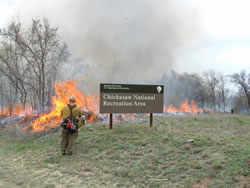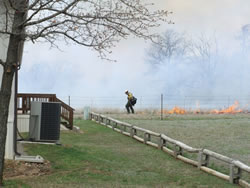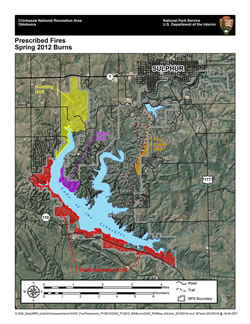National Cohesive Wildland Fire Management Strategy Success Story
Prairie Restoration Continues
Chickasaw National Recreation Area, Oklahoma
Cohesive Strategy – Maintain and Restore Landscapes
2012

South boundary of the park. March 16, 2012. NPS / Michelle Fidler.

Five Lakes area of the park. March 17, 2012. NPS / Michelle Fidler.

Burn Unit Map, Spring 2012.
In March 2012, thirty nine firefighters from lands managed by the Department of the Interior, including Lake Meredith National Recreation Area, Big Thicket National Preserve, Balcones Canyonlands National Wildlife Refuge, all in Texas, and Wichita Mountain National Wildlife Refuge in Oklahoma, Rocky Mountain National Park, Colorado, Buffalo National River, Arkansas, and Saguaro National Park, Arizona, came together at Chickasaw National Recreation Area to conduct prescribed burns in portions of the park.
In 2011, fire crews burned 2,184 acres of red cedar slash that had been left to dry after cutting. This year, fire crews burned an additional 650 acres, mostly in the south boundary unit along Goddard Youth Camp Road from the Arbuckle Dam to the eastern border of the park. In addition, they burned a section of the park near the Five Lakes area and small areas in the Guy Sandy vicinity. Firefighters still have plans to burn additional blocks in the South Boundary, Point, and Hunting areas of the park in the future when conditions are favorable for meeting resource objectives.
These burns were conducted as part of a continuing prairie restoration project to remove eastern red cedar slash that was cut during a $1.4 million American Recovery and Reinvestment Act (ARRA) project in the summer and fall of 2010.
The goals of the project are to remove eastern red cedar (Juniperus virginiana) from portions of the park and restore native grasslands to the park. Native to Oklahoma, eastern red cedar is extremely invasive. The tree species creates a wildfire hazard, displaces other species from the natural ecosystem, impairs local air quality by producing allergens, and contributes to the general decline of the local water table. Under natural conditions eastern red cedar is limited by periodic natural fires.
The burns are a part of the National Park Service's prescribed fire program to help protect local communities from the catastrophic effects of uncontrolled wildfires while promoting the natural ecosystem's ability to thrive. Prescribed fires improve forest health by promoting nutrient recycling, increasing habitat diversity, and reducing fuels that lead to unwanted, out-of-control wildfires.
Contact: Bruce Fields, Fire Management Officer, Bruce_Fields@nps.gov, (806) 865-3360 x426
Keywords: Partnerships, Fire Ecology and Restoration